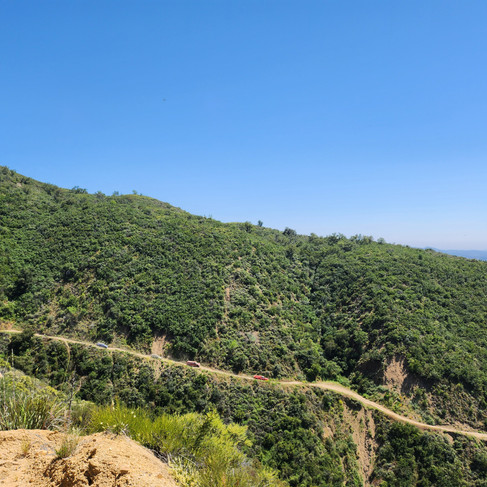CNNCTS partners came together at Palomar Mountain to join the Pauma Band of Luiseño Indians for a special occasion—a visit to the restoration and nature trail “demo project” led by the Tribe and its Forestry Department. Learn about our June visit on today’s blog!

On the early morning of June 6th, partners of the Collaborative for Native Nations for Climate Transformation and Stewardship (CNNCTS) joined together at the base of Palomar Mountain on the lands of the Pauma Band of Mission Indians for a special occasion—a visit to the restoration and nature trail “demo project” led by the Tribe and its Forestry Department. The project draws on Pauma’s extensive history of stewardship and post-fire recovery, and includes burn preparation, pile burning, and the construction of a nature trail for community members. Attendees from the CNNCTS network included the Pauma Band of Luiseño Indians, San Diego State University, Climate Science Alliance, La Jolla Band Of Luiseño Indians, Kumeyaay Community College, San Diego State University Field Stations, and Condor Visual Media, and invited guests from Tribal communities and organizations.
Attendees piled into vehicles and ascended Palomar Mountain, making new connections and taking in the vast scenery and diverse ecosystems over the hour-long journey. For the first site visit of the day, attendees explored a series of water retention ponds to see first-hand the benefits they were restoring to the surrounding ecosystem. Despite the biting horseflies, attendees were delighted to see juncus sprouting up along the water's edge, rainbow trout splashing at the surface, and admire the colorful dragonflies darting around. These were all signs of healthy waterways, explained by Pauma Forestry Manager, Cliff Devers, and reflect a return to balance that the Tribe has worked hard to implement. Dr. Stan Rodriguez of Kumeyaay Community College, and Climate Science Alliance Coastal Advisor, shared about the juncus plant and the role it plays in water quality, joining the Pauma Forestry Department in a demonstration of how to transplant juncus without harming the plant. Donning gloves provided by the Crew, attendees then lined up to haul these heavy water-saturated plants to areas receiving much-needed restoration.


Attendees took a break for snacks and a presentation from Allison Santos, Pauma Forestry Department Coordinator, on community involvement at the mountain—including volunteer days, an interagency pile burn, and owl nest-box building led by youth from the Pauma community! The group was then led on a tour of the newly constructed nature trail that is being constructed as part of CNNCTS. Cliff guided attendees along the trail pointing out wildfire management actions that are being planned by the Forestry Crew, including mechanical thinning and fuels reduction. The trail also passes by the Tribe’s NOAA rainfall tracker, which records water levels daily. Once completed, the trail will provide access for Tribal elders, community members, and visiting stewards to witness and learn from the restoration work carried out since the 2007 Poomacha fire. The trail meanders and winds through the trees, eventually leading to a sweeping vista of the area. The group took in the scenery before heading over to watch a milling demonstration from Lumbercycle, a local nonprofit that turns fallen trees into lumber that will be used for community projects. They are currently working with the mountain crew to mill trees for a large shaded pavilion that is planned to accompany the CNNCTS trail to host educational events.
The next stop on the day’s journey was Picnic Flats, the site of the prescribed pile burn held in March where over 40 piles of thinned brush were ignited as part of an interagency collaboration between Tribal, federal, state, and local partners. Attendees were able to see the vibrant growth that is already sprouting up two months later, and hear from the Pauma Forestry team on how they will continue to tend to the landscape in future burn events.
The green open space lended a beautiful backdrop for reflections and appreciations from the site visit hosts and attendees, before the group descended down the mountain.
It was an incredible opportunity to see first-hand a project that weaves together wildfire resilience, forest health, and community leadership. We look forward to seeing the demonstration project continue to support what one attendee stated in their reflection as, “...one of the best managed forests on the mountain”.

Stay tuned for more updates from the Pauma Forestry Department on their demonstration project and other efforts from the CNNCTS network of partners, by subscribing to our newsletter or following along on Instagram.












